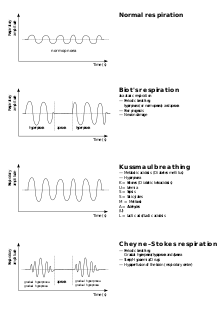Cheyne-Stokes breathing
When Cheyne-Stokes respiration - named after John Cheyne (1777-1836) and William Stokes (1804-1878) - is a pathological breathing form . It is characterized by a periodic increase and decrease in the depth of breath and the distance between the individual breaths. The shallowest breaths are often followed by a shorter breathing pause, then breaths begin again, which become increasingly deeper.
Cheyne-Stokes respiration is often found when there is insufficient cerebral blood flow , for example due to vascular sclerosis , strokes or poisoning . Cheyne-Stokes respiration has also been observed in hibernating animals.
clinic
Cheyne-Stokes breathing, a particularly severe form of sleep-disordered breathing (SBAS), is associated with severe forms of heart failure. The prevalence of Cheyne-Stokes respiration in these patients is 30–40%. With Cheyne-Stokes breathing, there is a periodically increasing and decreasing swelling of the breathing : The breaths become shallower and shallower until, after a pause of sometimes more than ten seconds, they become deeper and even more strenuous. In addition, the breathing rate can also change.
Cheyne-Stokes breathing often occurs at night in patients with advanced heart failure (central sleep apnea syndrome ), as well as with further damage to the central nervous system , for example with uremia or exogenous poisoning, and with overdoses of opioids such as polamidone (methadone). Cheyne-Stokes breathing can be a preliminary stage of pre-terminal gasping breathing , on the other hand it can also occur during normal sleep without any sign of illness . At altitudes above 3000 m, it often occurs mainly during sleep and is called periodic breathing. The altitude-related hyperventilation leads to a relative inhibition of the respiratory center in the medulla oblongata via the respiratory alkalosis , the breathing pauses last from 10 seconds to a minute. Due to the increase in CO 2 , deep breaths are initiated again via the carotid body, which in turn intensify the respiratory alkalosis, so that this phenomenon is self-sustaining. Periodic breathing is not considered a symptom of altitude sickness and it often continues to occur even after successful acclimatization, but it can interfere with sleep and nighttime recovery.
Pathophysiology
The cause is a non-linear sensitivity of the respiratory center to the CO 2 - partial pressure in arterial blood. Since the increasing partial pressure of CO 2 in the arterial blood acts as the strongest respiratory stimulus, the depth of breath and the respiratory frequency decrease until an increased CO 2 content in the blood forces you to breathe more intensely. This then begins to flatten again when enough CO 2 has been exhaled. Since the sensitivity to CO 2 is disproportionately lower at low partial pressures and disproportionately high at high partial pressures, "the regulator oscillates".
A negative influence of Cheyne-Stokes respiration on the clinical course of heart failure is discussed. The more pronounced the heart failure - and especially the left ventricular component - the more pronounced central and periodic breathing patterns can be.
therapy
For the treatment of Cheyne-Stokes respiration, anti-cyclically modulated ventilation (AZMV) or adaptive servo-ventilation (ASV) are used as ventilation methods, which have replaced the previously used BiPAP method (for bilevel positive airway pressure ). A mask system is used to automatically regulate the breathing pressure from breath to breath and the oscillation of the breathing regulation is mechanically dampened. These methods have various advantages over classic CPAP ventilation : They counter-cyclically balance out breathing fluctuations due to Cheyne-Stokes breathing and modulate the pathophysiological breathing pattern in the physiological direction.
Since the publication of the first results of the SERVE-HF study, the ASV should no longer be used due to the increased mortality in heart failure patients with restricted left ventricular ejection fraction .
In individual cases, the administration of additional oxygen (2–4 l / min) leads to a linearization of the respiratory response curve and thus to a medicamentous dampening of the oscillating breathing regulation.
In the case of acute altitude sickness, an immediate descent must be made until all symptoms have improved. This is necessary to ensure adequate oxygen supply again.
See also
Individual evidence
- ^ WA Müller, S. Frings: Animal and Human Physiology. 3. Edition. Berlin 2006, ISBN 3-540-32728-2 , p. 523.
- ^ O. Oldenburg, A. Lamp, L. Faber, H. Teschler: Sleep-disordered Breathing in Patients with Symptomatic Heart Failure. A contemporary study in prevalence and characteristics of 700 patients. In: European Journal of Heart Failure . 2007; 9, pp. 251-257.
- ↑ W. Galetke, N. Anduleit include: Evaluation of a new algorithm for patients with Cheyne-Stokes breathing and obstructive sleep apnea. Abstract 1560, ERS Congress, Stockholm 2007.
- ↑ M. Bögel (Red.): Sleep-related breathing disorders and cardiovascular risk. A position assessment. Weinmann Medical Technology, Hamburg 2009.
- ↑ http://dgk.org/daten/ErhoehtesMortalitaetsriskikobeiASV-Therapie_Stellungnahme_DGK.pdf
